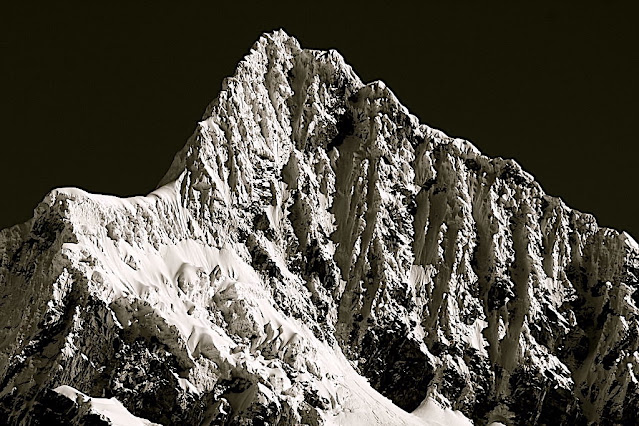%20Mountain%20peaks%20%20(Pico%20de%20Orizaba)watercolor%2026.6%20x%2037.4%20cm).png)
DIEGO RIVERA (1886-1957)
Pico de Orizaba / Citlaltépetl (5,636 m -18,491 ft)
Mexique
In Mountain peaks, aquarelle 26.6 x 37.4 cm
Le parc national Pico de Orizaba a été créé le 16 décembre 1936 sur une superficie de 19 750 ha afin de protéger la richesse naturelle du volcan, ses environs et les localités de Tlachichuca, Ciudad Serdán, La Perla, Mariano Escobedo et Calcahualco. Le décret fédéral a été traduit en loi fédérale le 4 janvier 1937.
Le pic d'Orizaba est une figure majeure dans les cultures pré-hispaniques, comme chez les Aztèques et les Totonaques. Le volcan est l'objet de nombreuses mythologies autochtones. Chez les Olmèques, Orizaba est l'esprit d'un aigle réincarné en volcan ; le fait de le gravir et de prier au sommet prévient de ses colères et l'empêche d'entrer en éruption.
Le peintre
Diego María de la Concepción Juan Nepomuceno Estanislao de la Rivera y Barrientos Acosta y Rodríguez, plus connu sous le nom de Diego Rivera est un peintre mexicain. Bien qu'il ait tout au long de sa vie pratiqué la peinture de chevalet, Rivera est mondialement connu pour ses peintures murales, réalisées au Mexique, principalement à Mexico, et aux États-Unis. Ses peintures murales sont indissociables de ses convictions communistes et de sa fascination pour le passé préhispanique du Mexique. Il fut l'époux de l'artiste Frida Kahlo. De 1913 à 1918, ses peintures sont d'inspiration cubiste (dont Paysage zapatiste - Le Guérillero, 1915). À la suite d'un conflit avec le critique d'art Pierre Reverdy, il rompt avec le cubisme et revient à la figuration. Son voyage en Italie en 1920 lui fait découvrir les fresques murales qui vont l'inspirer pour son œuvre ultérieure la plus connue, ses immenses peintures murales. Il utilise pour cela les pigments traditionnels utilisés à l'époque pré-hispanique. Les thèmes traités sur commande du gouvernement sont sociaux et historiques, concernant l'histoire officielle récente du Mexique. L'inspiration est également politique avec la représentation du travail ouvrier (L'industrie de Detroit, 1932-1933).
Rivera a fait l'objet de nombreuses critiques de son vivant, notamment de la part de David Alfaro Siqueiros, qui l'accusa, dans un article publié le 29 mai 1934 par le magazine New Masses d'être un opportuniste, d'avoir une vision idéalisée et fausse des indigènes, d'être un touriste mental (parce qu'il s'était « planqué » à l'étranger durant la révolution), un snob, un saboteur du travail collectif, le peintre de la nouvelle bourgeoisie et des millionnaires, techniquement dépassé, de dépendre financièrement des subsides du gouvernement et d'être un de ses agents, un esthète de l'impérialisme.
______________________________
2024 - Gravir les montagnes en peinture
Un blog de Francis Rousseau


%20Popocatepetl,%20Spirited%20Morning:%20Mexico%20(1932)%20Oil%20on%20board,%2063.5%20x%2073.7%20cm.%20Smithsonian%20American%20Art%20Museum,%20Washington%20DC%20.jpg)













